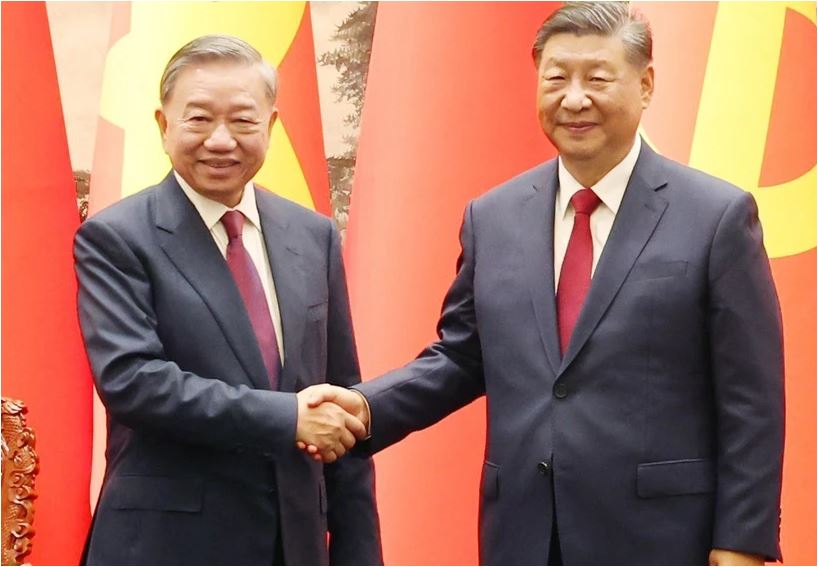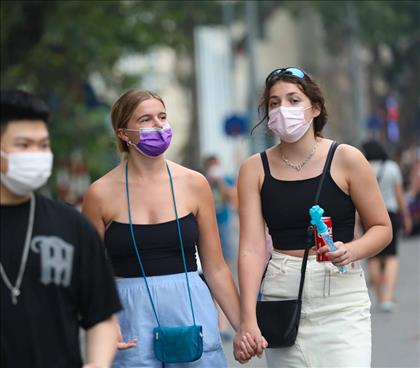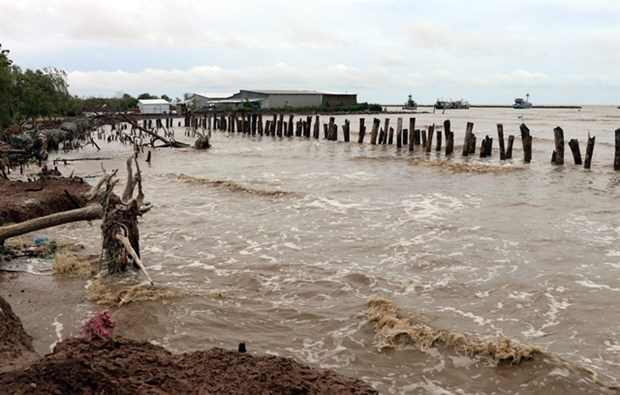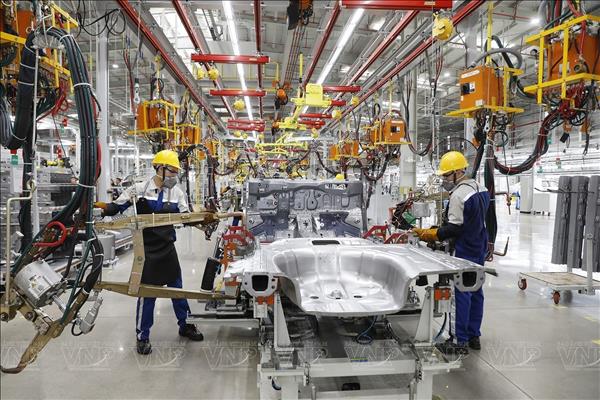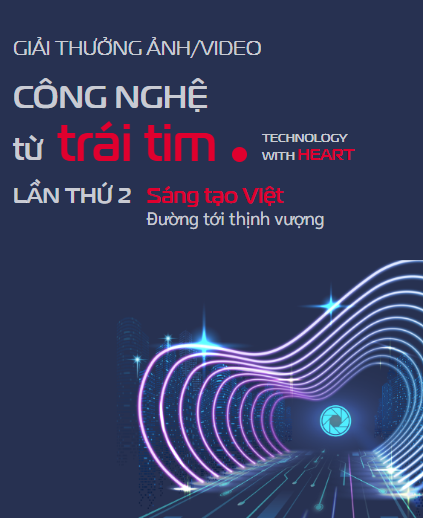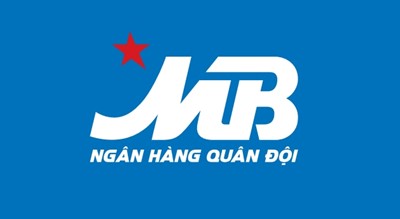The upcoming state visit to Vietnam by General Secretary of the Communist Party of China (CPC) Central Committee and President of China Xi Jinping, scheduled for April 14–15, carries significant strategic meaning for bilateral ties, stated Deputy Prime Minister and Minister of Foreign Affairs Bui Thanh Son in an interview with the press ahead of the visit.
Following is the contents of the interview:
Reporter: Could you please highlight some key results in Vietnam–China cooperation in recent years?
Deputy PM and FM Bui Thanh Son: Vietnam and China are close neighbours, sharing mountains and rivers, with a long-standing tradition of friendship between their people. Since the establishment of the comprehensive strategic cooperative partnership in 2008, and particularly following recent mutual visits between the two countries' top leaders, bilateral ties have seen comprehensive and robust progress across multiple areas.
First, political trust has been enhanced through frequent high-level visits and contacts, both bilaterally and multilaterally. Following the official visit to China by General Secretary of the Communist Party of Vietnam (CPV) Central Committee Nguyen Phu Trong (October 2022) and Xi's third state visit to Vietnam (December 2023), both sides agreed to deepen and elevate their comprehensive strategic cooperative partnership, and jointly build a “Vietnam–China community with a shared future that carries strategic significance,” based on six major orientations — stronger political trust, more substantive defence-security cooperation, deeper practical cooperation, stronger social foundation, closer multilateral coordination, and better control and settlement of differences - marking a new development phase in bilateral relations.
During the state visit to China by CPV General Secretary and State President To Lam in August 2024, the top leaders of the two Parties and countries reaffirmed that developing bilateral relations remains a top priority and a strategic choice in Vietnam's foreign policy and China's neighbourhood diplomacy. They agreed to further strengthen the comprehensive strategic cooperative partnership and promote the building of a community with a shared future that carries strategic significance, thereby injecting new momentum into the positive trajectory of bilateral ties and fostering vibrant, practical cooperation across sectors. Multilaterally, the two countries have enhanced coordination within international and regional mechanisms such as the United Nations, the Asia-Pacific Economic Cooperation (APEC), and the Greater Mekong Sub-region (GMS). Most recently, Prime Minister Pham Minh Chinh attended the 8th GMS Summit in China (November 2024), where leaders from Vietnam, China, and other member countries affirmed their solidarity and friendship and pledged to realise a shared aspiration and vision for regional peace and prosperity through joint efforts, common voices and unified actions.
Meanwhile, cooperation and exchanges through Party, parliament, and fatherland front channels as well as collaboration among ministries, sectors and localities have continued to expand, particularly among those responsible for foreign affairs, national defence, and public security, as well as among border localities. These exchanges have led to the development of numerous practical and effective mechanisms and joint cooperation programmes.
Second, economic, trade, investment, and infrastructure connectivity cooperation has made strides. In 2024, bilateral trade reached new heights, exceeding 200 billion USD according to Vietnamese statistics, and 260 billion USD according to Chinese figures. Vietnam remains China’s largest trading partner in ASEAN and its fourth-largest trading partner globally. In the first quarter of 2025, the figure hit 51.25 billion USD, up 17.46% year-on-year. China has become the largest market for Vietnamese agricultural, forestry, and fishery products, bringing tangible benefits to millions of Vietnamese farmers. In terms of foreign direct investment (FDI), China is currently Vietnam’s sixth-largest investor, with total registered capital of 31.26 billion USD. The two sides have reached a consensus on orientations to deal with several key projects facing obstacles. Infrastructure connectivity, particularly in railways, has seen important progress. The two countries have closely cooperated in planning the Lao Cai–Hanoi–Hai Phong railway. Vietnam aims to begin construction on this line in 2025. Planning for the Mong Cai–Ha Long–Hai Phong and Dong Dang–Hanoi railway lines is expected to be completed in 2026. These projects will facilitate cross-border travel and trade. The pilot implementation of a smart border gate is also making positive headway.
Third, to mark the 75th anniversary of bilateral diplomatic relations (January 18, 1950 – 2025), in January 2025, To Lam and Xi Jinping held an important phone conversation officially launching the "Year of Vietnam-China Humanistic Exchange," creating a momentum to boost people-to-people, cultural, and tourism exchanges, which have already been vibrant and diverse. Many socio-political organisations and localities in both countries have established and maintained regular cooperation mechanisms and programmes. Currently, about 24,000 Vietnamese students are studying in China — double the number five years ago. In tourism, China remains the top source of international visitors to Vietnam post COVID-19.
Fourth, both sides have effectively managed and satisfactorily solved differences and maintained peace and stability in the East Sea. Based on the agreement on basic principles guiding the settlement of sea-related issues signed in 2011 and the mechanism of Vietnam–China governmental-level negotiation on border and territory, as well as various mechanisms for dialogue and negotiation on sea-related matters, both sides have maintained regular exchanges and sped up the timely settlement of emerging issues, manage differences properly, and achieved positive results, notably in cooperation in less sensitive areas at sea, contributing to regional and global peace and stability.
Reporter: Could you share the significance and expectations of the upcoming state visit to Vietnam by Party General Secretary and President of China Xi Jinping, especially as this year marks the 75th anniversary of the establishment of diplomatic relations between the two countries ( January 18, 1950 – 2025)?
Deputy PM, FM Bui Thanh Son: Taking place less than a year after the state visit to China by Party General Secretary To Lam, the upcoming state visit to Vietnam by Party General Secretary and President of China Xi Jinping is an important diplomatic and political event of strategic significance for both Parties and both nations. It is expected to exert long-term influence on the development of Vietnam–China relations as the two countries enter a new era of development.
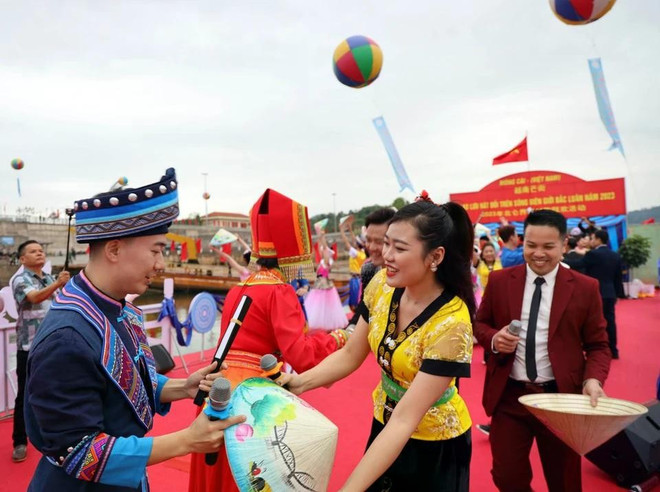
This marks Xi Jinping’s fourth visit to Vietnam in his capacity as China’s top Party and State leader, and his second during the current terms of the 13th National Congress of the Communist Party of Vietnam and the 20th National Congress of the Communist Party of China. Notably, it also coincides with the “Year of Vietnam - China Humanistic Exchange” and the 75th anniversary of the establishment of diplomatic relations between the two countries (1950–2025).
During the visit, Xi Jinping is scheduled to hold high-level talks with Party General Secretary To Lam and State President Luong Cuong, and meet with Prime Minister Pham Minh Chinh and National Assembly Chairman Tran Thanh Man. Their discussions will focus on major directions and measures to further advance bilateral ties across multiple areas. Xi Jinping is also expected to participate in a number of other key diplomatic activities.
Vietnamese Party and State leaders have expressed strong anticipation and high expectations for a successful visit, with four key goals:
First, to strengthen high-level strategic exchanges, especially regular contact between the top leaders of the two Parties and countries. This would reinforce the foundation of political trust, enable the sharing of experience in national governance and development, and provide guidance for the stable and healthy growth of bilateral relations amid the complex regional and global situation.
Second, to identify key areas and directions for bilateral cooperation, while enhancing the quality, efficiency, and sustainability of practical collaboration. The visit aims to foster “high-standard cooperation highlights” in the fields where Vietnam has demand and China holds strengths, such as standard-gauge railways, agricultural trade, science and technology, education and training, digital economy, and green economy, meeting the aspirations and interests of the peoples of both countries. Around 40 cooperation agreements between ministries, agencies, and localities are expected to be signed during the visit, laying a solid groundwork for more effective future cooperation.
Third, to extend the positive momentum of the visit throughout all levels, sectors, and communities in both countries. This includes effective implementation of the 2025 Year of Vietnam - China Humanistic Exchange, promoting exchanges among mass organisations and socio-political bodies, and expanding local-level partnerships. These efforts aim to deepen mutual understanding and trust, reinforce traditional friendship, and strengthen public support for bilateral ties.
Fourth, through exchanges conducted in a spirit of frankness, sincerity, and mutual understanding, both sides will put themselves in each other’s position to properly address border and territory-related issues, better manage and resolve maritime disagreements in line with high-level common perceptions, ensuring that maritime issues do not hinder the healthy development of relations between the two Parties and the countries and contribute to maintaining peace, stability, cooperation, and development in the region and the world.
The state visit is just a few days away. I firmly believe that, with the great importance attached to it, the close coordination, and thorough preparations by both sides, Xi Jinping’s fourth state visit to Vietnam will be a success in all aspects, marking a new milestone in the friendly neighbourliness and comprehensive strategic cooperative partnership between the two countries, as well as the Vietnam-China community with a shared future that carries strategic significance.
Reporter: What is the significance of the Year of China-Vietnam Humanistic Exchange for the relationship between the two countries?
Deputy PM, FM Bui Thanh Son: During the state visit to China by Party General Secretary To Lam in August 2024, the top leaders of the two Parties and countries agreed to make 2025 the Year of China-Vietnam Humanistic Exchange on the occasion of the 75th anniversary of bilateral diplomatic relations. This is an important common perception of the top leaders, reached after the Vietnam-China relationship was upgraded to a new position with the building of a Vietnam-China community with a shared future which carries strategic significance in December 2023. The relationship has witnessed a strong and comprehensive transformation in accordance with the six major orientations.
The implementation of the Year of China-Vietnam Humanistic Exchange is very significant to the relationship between the two Parties and the two countries.

First of all, it is an opportunity for both sides to reflect on the shared journey and to pay tribute to the great contributions of earlier generations of leaders from both Parties and countries, most notably Presidents Ho Chi Minh and Mao Zedong, who laid the foundations for and made tremendous efforts to nurturing and developing the comrades-plus-brothers Vietnam–China relationship. Their efforts established a solid foundation for the friendly neighbourliness and comprehensive cooperation between Vietnam and China today.
Second, it serves as both a driving force and an opportunity for the two sides to further promote cooperation in culture, education, and tourism; and to jointly organise friendship exchange activities in an intensive and extensive manner, enabling people from all walks of life in both countries to gain a more thorough understanding of each other’s culture, country, and people. In particular, it allows the younger generations of both nations to follow the footsteps of their predecessors to inherit, preserve, and continuously promote the fine values of the traditional friendship, a precious shared asset of the two Parties, the two countries, and their people.
Third, the Year of China-Vietnam Humanistic Exchange serves as a “catalyst” and a bonding agent to strengthen exchanges and cooperation among ministries, sectors, localities, and mass organisations of the two countries. It helps them effectively implement high-level agreements and high-level common perceptions, especially the joint statements and signed documents. Through this, the two sides can achieve more substantive outcomes in their bilateral relations, making practical contributions to the prosperous development of each country in the new era.
Fourth, the activities and positive outcomes mentioned above will help consolidate the social foundation of the bilateral relations, and foster a positive and trustworthy atmosphere that is conducive to controlling differences, negotiating to effectively resolve pending issues in the relationship, contributing to maintaining peace, stability, and development in the region and the world.
Reporter: Could you share your assessment of the potential and significance of Vietnam–China cooperation in science and technology in achieving each country’s national goals? In particular, what does this mean for Vietnam in its era of the nation’s rise?
Deputy PM, FM Bui Thanh Son: Over more than 45 years of reform and opening, China has made remarkable progress in science and technology, evolving from a latecomer to a global powerhouse. Today, it ranks third in the world in terms of investment in research and development (R&D) and leads the world in the number of patents granted.
Notably, in recent years, China has continuously announced groundbreaking achievements in key technological fields such as artificial intelligence (AI), 5G networks, robotics, semiconductors, and space technology, earning worldwide admiration. It can be said that, in just over four decades, China has covered a journey that took many other countries more than two centuries to complete.
For Vietnam, the Party and State have always attached great importance to the decisive role of science and technology in the country’s sustainable development. In recent years, numerous key political documents have been issued to reflect this vision, most notably, the Politburo's Resolution No. 57-NQ/TW dated December 22, 2024, on breakthroughs in science, technology, innovation, and national digital transformation. The resolution underscores that the development of science, technology, innovation, and national digital transformation should be a top breakthrough and a key driving force for rapidly advancing modern productive forces, perfecting production relations, reforming national governance, promoting socio-economic development, preventing the risk of falling behind, and propelling the country toward breakthrough growth and prosperity in the new era.
To help realise its strategic development goals and vision, Vietnam aims to optimise its existing advantages, including an abundant and increasingly skilled workforce, an improved investment attraction policy, and a promising market for research and development (R&D). The move is to strengthen and expand international cooperation in science and technology, innovation, and national digital transformation, while intensively and extensively integrating into global high-tech and key technology production and supply chains.
China’s success has served as a great source of inspiration for progressive forces around the world, offering new development opportunities for the modernisation efforts of developing countries, including Vietnam. There is vast potential and space for science and technology cooperation between Vietnam and China.
Vietnam stands ready to further deepen its cooperation with China in this field, and hopes that China will enhance collaboration in the training of high-quality human resources, technology transfer, and financial support in order to lay a solid foundation for both countries to enter a new era of prosperous development.
Reporter: Thank you very much!/.

